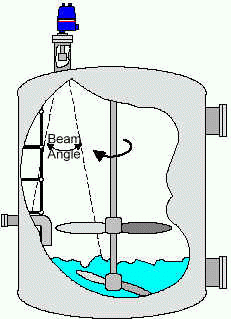Ultrasonic transmitters work on the principle of sending a sound wave from a peizo electric transducer to the contents of the vessel.
The device measures the length of time it takes for the reflected sound wave to return to the transducer.
A successful measurement depends on reflection from the process material in a straight line back to the transducer.
Ultrasonic Level Sensor Theory

Advantages
The main advantages of ultrasonic level instrumentation are that the transducer does not come into contact with the process material, they have no moving parts and a single top of vessel entry makes leaks less probable than fully wetted techniques.
Disadvantages
There are various influences that affect the return signal. Things such as powders, heavy vapors, surface turbulence, foam and even ambient noise can affect the returning signal.
Temperature can also be a limiting factor in many process applications. Ultrasonic devices will not operate on vacuum or high pressure applications.
Practical Notes
Successful measurement depends on the transmitter being mounted in the correct position so that the internal structure of the vessel will not interfere with the signal path. To ignore obstructions in the vessel, tank mapping has been developed. Tank mapping lets the operator take a “sonic snapshot” of an empty vessel.
The transducer transmits a sound burst and the echo is recorded as a signature of the tank. Any obstructions in the vessel will send an echo and create a profile. Later on, this signature or profile is locked into the ultrasonic unit’s memory so it will not respond to echoes created by these obstructions.